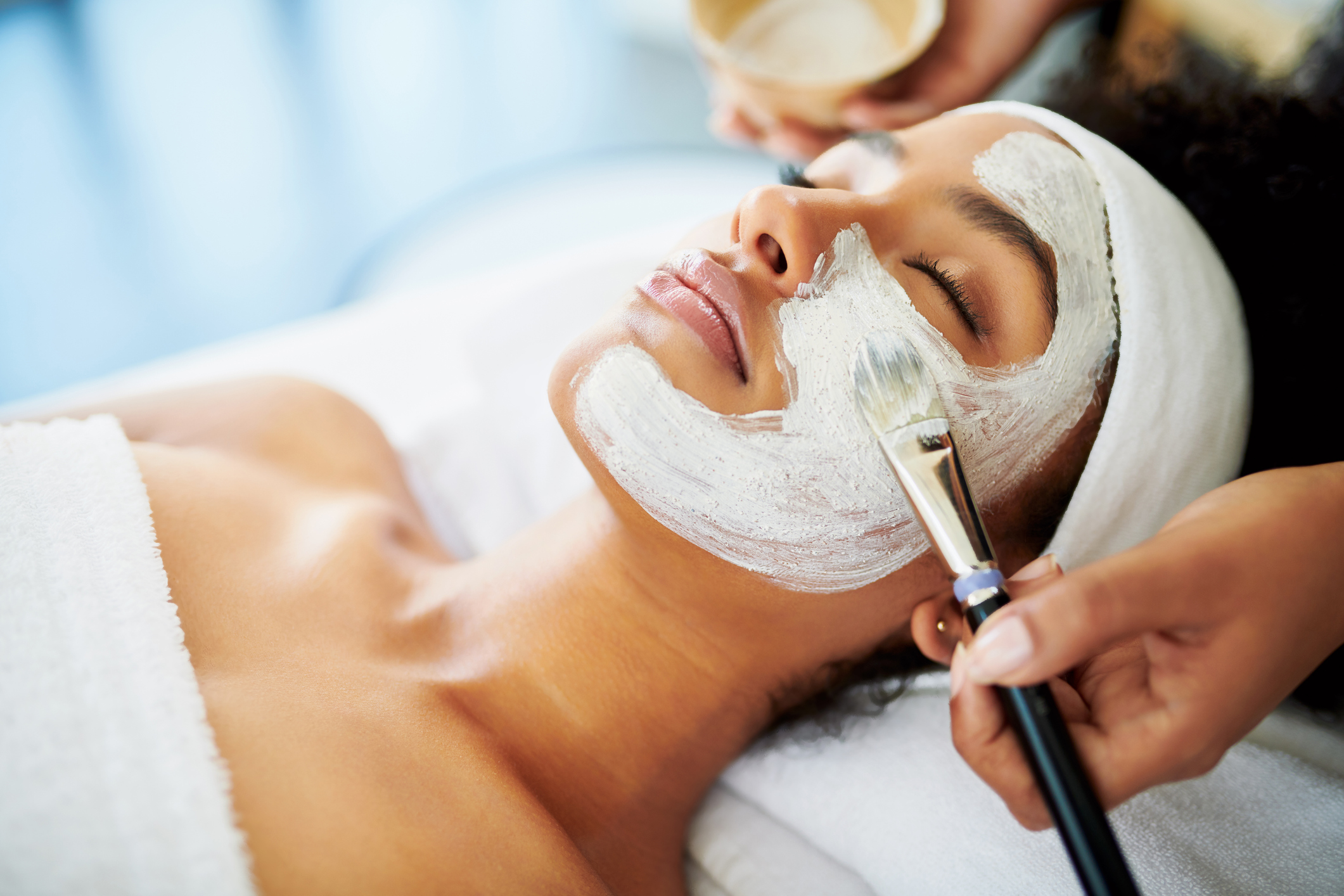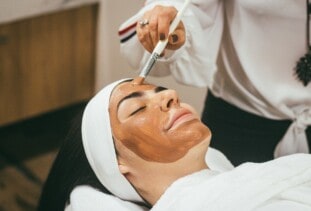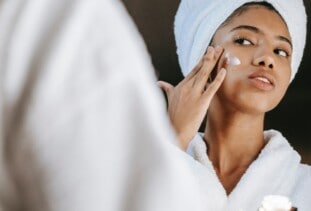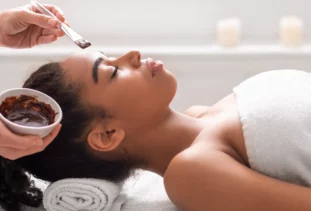A facial is a form of skin care that commonly includes cleansing, exfoliation, and extraction. Of course, it’s more than that. Pampering facials can improve not just the look and feel of your skin but also your mood. This post takes you through the facial process so that you know how to prepare, what to expect, and how best to care for yourself after you’ve received a facial.
How to Prepare for a Facial
The work begins on your face before you enter the estheticians office. To get the best results from your facial, follow these simple steps:
- Bring a list of the products you use. A skin care professional needs to know all the items touching your skin on a regular basis to choose products that won’t negatively interact with them.
- Avoid prolonged sun exposure. Sun can dehydrate your skin and make it sensitive to products during a facial.
- Be gentle with your face. In the week before your facial, you should avoid strong skin care treatments that contain ingredients that make your skin too sensitive to benefit from a facial. When in doubt, consult with your esthetician.
- Skip waxing, tweezing, or shaving your face. Avoid these activities 24 to 48 hours before your facial, because they can irritate or damage your skin.
- Choose comfy clothes for the facial. Depending on where you get your facial, you may need to change into a gown. Wearing comfortable clothes allows you to get in and out of them easily and helps you feel even more relaxed during your facial.
Apply makeup or skip it. Because estheticians always clean skin during a facial, there’s no need to wear makeup to a facial visit. However, if you’re coming to the salon straight from work and wearing full makeup, don’t worry, your esthetician will wash off your makeup.
7 Step Facial Process
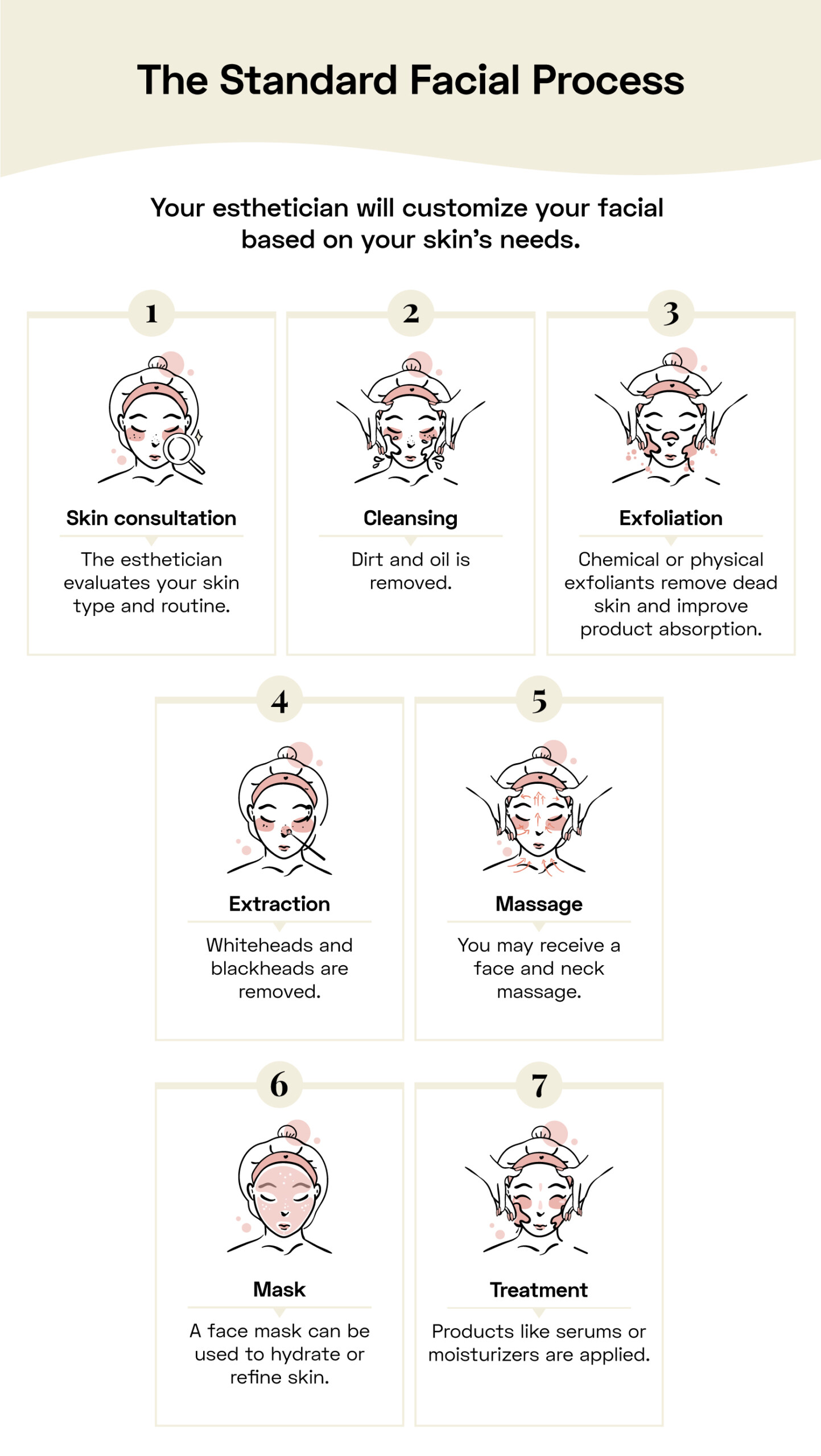
Although estheticians may customize treatments based on skin conditions and goals, standard facials follow this process:
1. Skin Consultation
Upon first meeting with you, an esthetician analyzes your skin’s health to determine what type of treatments or extractions you need. Before a facial begins, let the skin care professional know all about your allergies, skin routine, diet, skin type, and other health information.
2. Cleansing
A cleanser is the first tool skin professionals reach for. Removing dirt and oil is an important step of every facial.
3. Exfoliation
Exfoliation is any technique that gets rid of dead skin cells. Without dead skin cells on the outer layer of skin, the skin is clearer and brighter. Exfoliation takes many forms, including scrubbing and chemical exfoliants, but gentle exfoliating acid, enzyme peel, ultrasonic exfoliation, microdermabrasion, and bio-abrasion are the most common.
4. Extraction
Removing blackheads and whiteheads is an optional step but often recommended. Estheticians can extract blackheads and whiteheads without allowing bacteria to seep back into pores.
5. Massage
Volumes of research tout the healing and relaxing powers of massage. These benefits extend to the face. Facial massages increase circulation and relax muscles.
6. Mask
Estheticians can use various types of masks near the end of your facial. Masks can hydrate, reduce inflammation, moisturize, refine pores, and push skin care products deeper into the skin.
7. Treatment
A few maintenance steps end facials. Estheticians may apply moisturizer, serums, sunscreen, acne treatment, or other skin care products to keep the skin healthy and beautiful.
Tips for Post-Facial Success
To maintain the health and healthy glow of a facial, follow these steps the first days after your facial, when your skin is a little sensitive:
- Avoid touching your face. Even slight touching of your already sensitive skin can lead to irritation. If you tend to rest your chin in your hand, rub your eyes, or brush hair off your face, be mindful to avoid this type of contact with your face for a few days.
- Do not schedule a workout directly after the facial. Sweat and high heat can irritate skin, which needs a few days to heal after a facial.
- Take a break from makeup. After a facial, your pores are more open than normal, making them an inviting place for bacteria.
- Gently wash your face with a cleanser. You should skip skin care products, such as toners, retinols, peels, exfoliators, and face scrubs for one to three days after a spa treatment because they could be too harsh following a facial.
The Benefits of a Facial
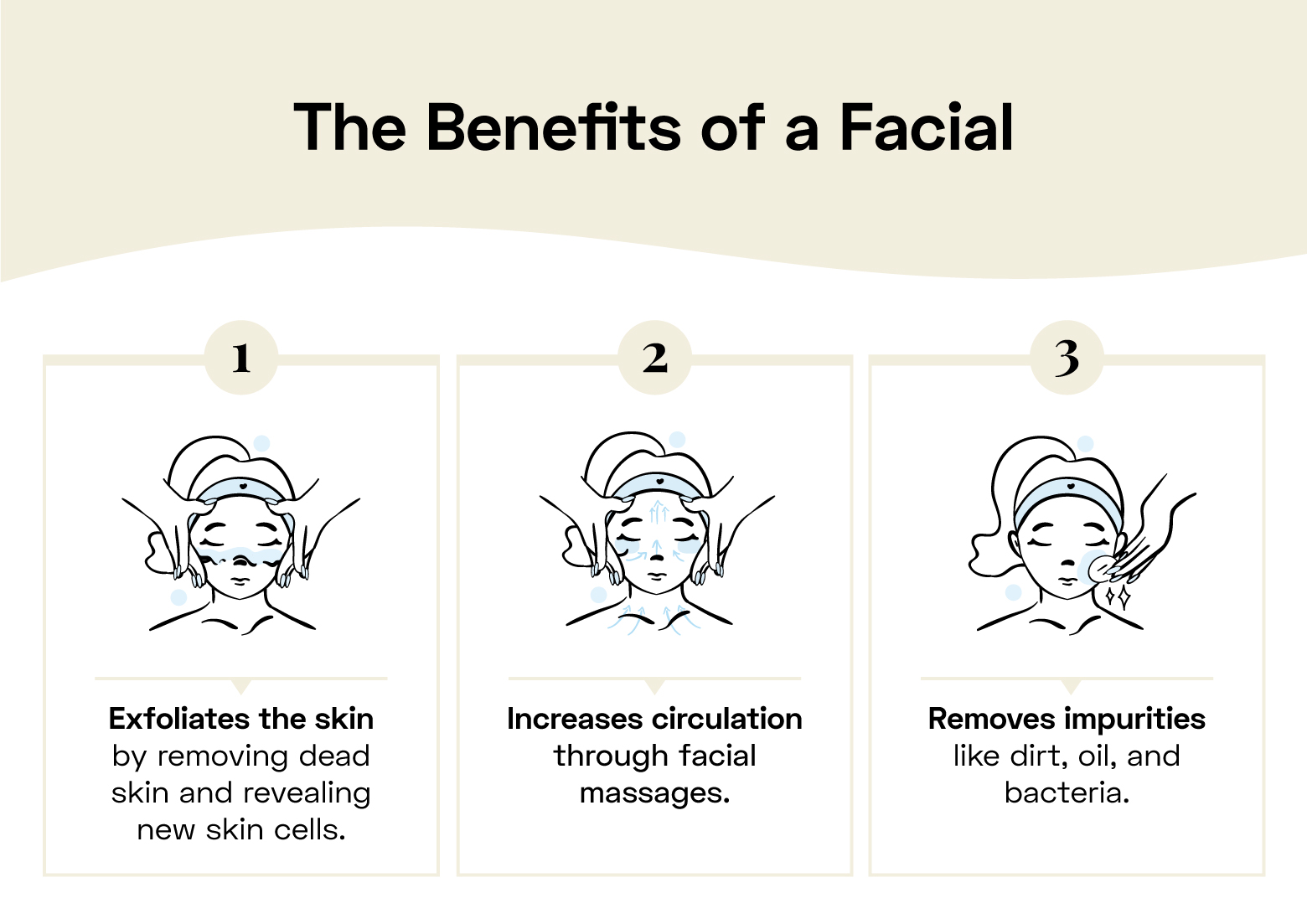
In addition to being relaxing, facials provide several health and aesthetic benefits, like:
- Exfoliating the skin. When a facial sloughs off dead skin cells at the skin’s surface, it reveals healthy new skin.
- Increasing circulation. The facial massage that is an integral part of a facial increases circulation, which produces clear, glowing skin.
- Removing impurities. Facials get rid of dirt, excess oil, germs, and bacteria.
Who Gives Facials?
Estheticians and dermatologists offer a wide array of facials that improve the appearance and health of skin using abrasive, burning, or chemical processes. Because these estheticians and skin doctors are well trained and licensed, you have little reason to worry if your face is a little red or irritated for a few days after a session of exfoliating, scrubbing, or pricking.
How Much Do Facials Cost?
The average cost for a facial is $63, but prices vary depending on the type of facial and your location. A deep pore facial typically ranges from $30 to $145, while microdermabrasion can cost $55 to $250.
How Long Do Facials Take?
An esthetician takes 60 to 90 minutes to perform a facial treatment. Your first facial may take a little longer because your esthetician needs to perform skin analysis, ask about your skin care routine, find out about any skin conditions you have, and inquire about your skin concerns.
How Often Should I Get a Facial?
Typically, estheticians recommend facial treatments every four to six weeks because it takes about four weeks for skin to regenerate. Your skin condition, skin issues, and skin goals determine the best facial frequency for you. Talk to your esthetician to determine the best frequency for your skin.
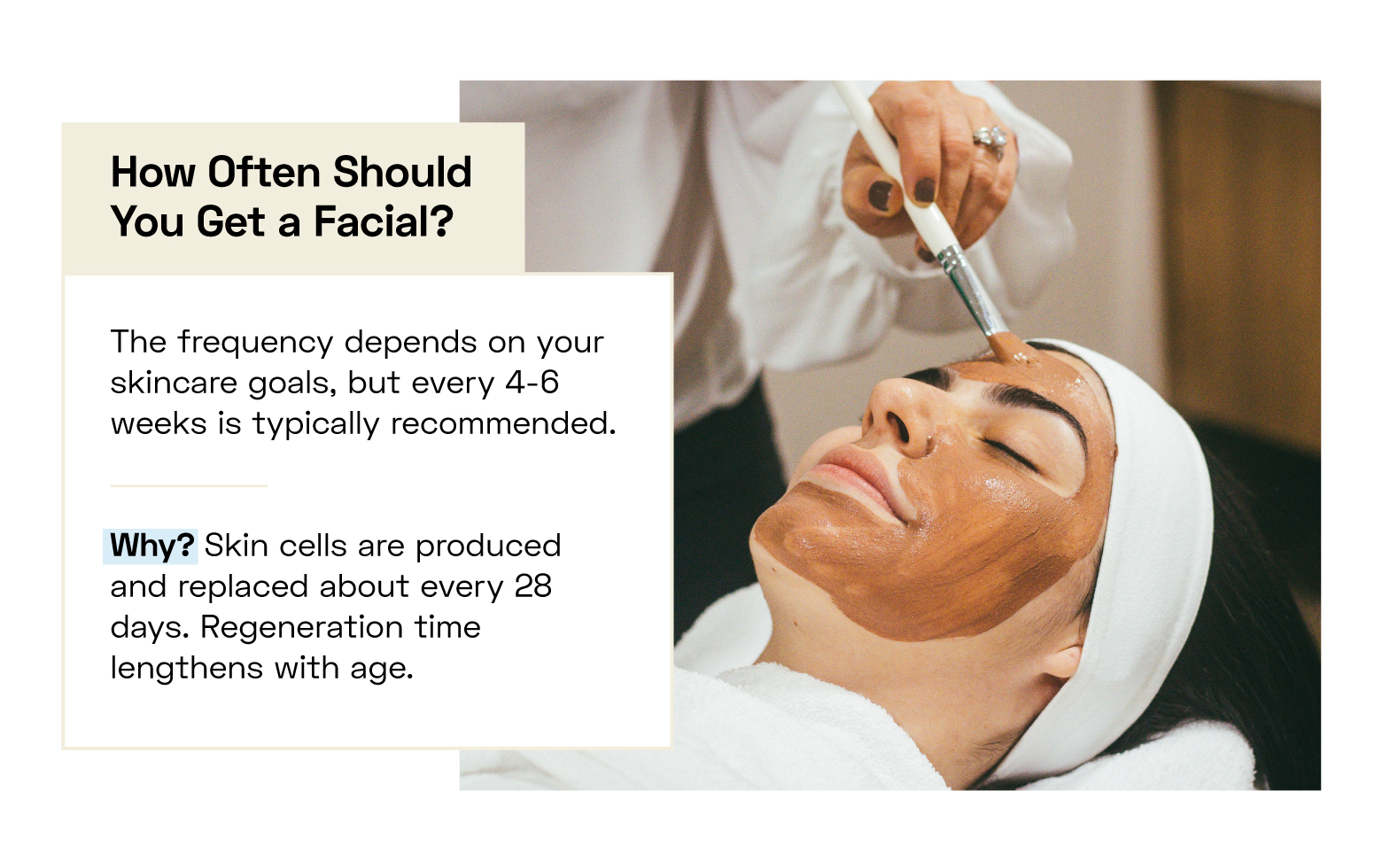
Consider these recommendations for scheduling facial treatments based on your skin tone and skin conditions:
- One per week for the first month if you are new to facials or if you have specific skin concerns, such as acne scars
- Once a month if you have oily to dry skin
- Every two months if you have already met your skin goals
- Every six months if you don’t have any skin issues and are looking for some pampering
What Are the Types of Facials?
The type of facial that works best for you depends on several factors, so use this guide to better understand the different facials you can choose from:
- Microdermabrasion: In this type of facial, an esthetician or dermatologist gently uses fine crystals to exfoliate the skin. Performed over several sessions, microdermabrasion can rejuvenate the skin, remove dark spots on acne-prone skin, and balance uneven skin tones, producing bright skin with an anti-aging effect. Microdermabrasion is safe for all types of skin.
- Chemical peels: A chemical peel involves peeling away the outermost layers of skin to uncover fresh skin. While you may leave this facial treatment with a sunburned feeling, your skin will look and feel tight and toned from the treatment. Chemical peels are not recommended for darker skin tones.
- Lymphatic massage. This series of pressure and rubbing on areas of the neck and face stimulates the lymphatic system’s removal of toxins from the body. This spa treatment reduces inflammation in the face and surrounding areas and increases blood flow, which reduces bags and dark circles under the eyes. Estheticians and dermatologists recommend lymphatic massage for people with sensitive skin or skin conditions that prevent them from using more abrasive facial treatments.
- Dermaplaning: With dermaplaning, a small blade scrapes away dead skin cells on the surface skin layer, revealing soft skin with a more even tone and texture. Mild redness and breakout of whiteheads are possible side effects of this mild skin treatment. This facial only needs to be done once and is fine for all types of skin.
- Microneedling: A series of pricks on a roller-like tool stimulate the production of collagen and elastin to make skin tight and smooth, reduce wrinkles and acne scars, and close pores. Microneedling can be used as a spot treatment and works for all skin types.
- LED light therapy: Red and blue non-UV lights penetrate into different levels of the skin to reach two different categories of skin cells. Red LED stimulates fibroblasts, which trigger collagen production, and blue stops overactive sebaceous glands from making too much oil. The Red LED reduces scarring and improves the skin’s elasticity and the blue helps people with oily or acne-prone skin. LED light therapy can benefit all skin types, but especially those who are acne-prone or have scarring.
- Brightening and oxygenating: Oxygen facials work like super cleansers. An esthetician uses a wand that blows highly pressurized air over sterilized skin. This powerful gas deeply exfoliates skin, leaving it younger and tighter looking. Plus, it promotes collagen production. This type of facial has a shorter recovery period and is recommended for all skin types.
Deciding on Your Skin Care Needs
Facials offer pampering and self care as well as promote self-confidence by reducing fine lines and wrinkles and by revealing tight, bright skin. So take good care of your skin with the Pros at StyleSeat — quality skin care professionals who can help you create a skin care routine for your needs and choose the best products for your skin and lifestyle.
